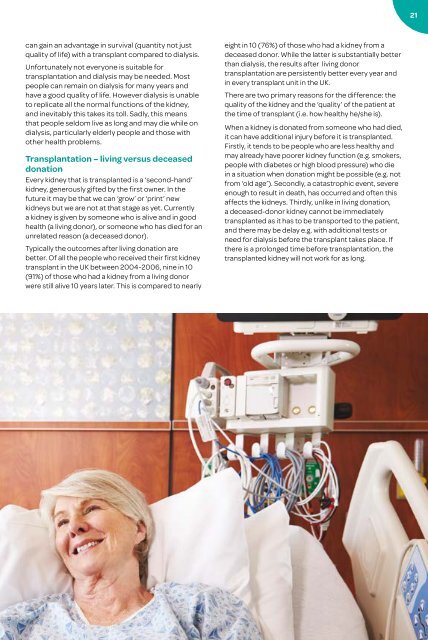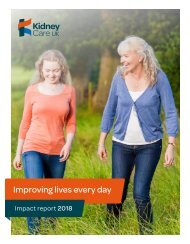Kidney Matters - Issue 7 Autumn 2019
Kidney Matters is our free quarterly magazine for everyone affected by kidney disease. This issue includes a delicious mexico bean nacho recipe from our Kidney Kitchen as well as articles about dialysis away from base, kidney stones, and a feature on looking out for children and young people with kidney disease. We know that being a kidney patient can be tough at times and that accessing the right help at the right time isn’t always easy. We’ve spent a great deal of time over the past year talking to kidney patients on dialysis, asking them what we can do to address this. The response was overwhelmingly ‘improved communication’ on what is going on in the kidney world and what is available to them in terms of support and how to access it. Kidney Matters has been developed to tackle this as well as the many other issues kidney patients face in day-to-day life. Along with shared patient experiences, Kidney Matters provides on how to access emotional and practical support, financial assistance through our grant schemes, advice from leading kidney specialists and tips on how to keep as well as possible by eating a healthy diet whilst on dialysis.
Kidney Matters is our free quarterly magazine for everyone affected by kidney disease.
This issue includes a delicious mexico bean nacho recipe from our Kidney Kitchen as well as articles about dialysis away from base, kidney stones, and a feature on looking out for children and young people with kidney disease.
We know that being a kidney patient can be tough at times and that accessing the right help at the right time isn’t always easy. We’ve spent a great deal of time over the past year talking to kidney patients on dialysis, asking them what we can do to address this. The response was overwhelmingly ‘improved communication’ on what is going on in the kidney world and what is available to them in terms of support and how to access it.
Kidney Matters has been developed to tackle this as well as the many other issues kidney patients face in day-to-day life. Along with shared patient experiences, Kidney Matters provides on how to access emotional and practical support, financial assistance through our grant schemes, advice from leading kidney specialists and tips on how to keep as well as possible by eating a healthy diet whilst on dialysis.
Create successful ePaper yourself
Turn your PDF publications into a flip-book with our unique Google optimized e-Paper software.
21<br />
can gain an advantage in survival (quantity not just<br />
quality of life) with a transplant compared to dialysis.<br />
Unfortunately not everyone is suitable for<br />
transplantation and dialysis may be needed. Most<br />
people can remain on dialysis for many years and<br />
have a good quality of life. However dialysis is unable<br />
to replicate all the normal functions of the kidney,<br />
and inevitably this takes its toll. Sadly, this means<br />
that people seldom live as long and may die while on<br />
dialysis, particularly elderly people and those with<br />
other health problems.<br />
Transplantation – living versus deceased<br />
donation<br />
Every kidney that is transplanted is a ‘second-hand’<br />
kidney, generously gifted by the first owner. In the<br />
future it may be that we can ‘grow’ or ‘print’ new<br />
kidneys but we are not at that stage as yet. Currently<br />
a kidney is given by someone who is alive and in good<br />
health (a living donor), or someone who has died for an<br />
unrelated reason (a deceased donor).<br />
Typically the outcomes after living donation are<br />
better. Of all the people who received their first kidney<br />
transplant in the UK between 2004-2006, nine in 10<br />
(91%) of those who had a kidney from a living donor<br />
were still alive 10 years later. This is compared to nearly<br />
eight in 10 (76%) of those who had a kidney from a<br />
deceased donor. While the latter is substantially better<br />
than dialysis, the results after living donor<br />
transplantation are persistently better every year and<br />
in every transplant unit in the UK.<br />
There are two primary reasons for the difference: the<br />
quality of the kidney and the ‘quality’ of the patient at<br />
the time of transplant (i.e. how healthy he/she is).<br />
When a kidney is donated from someone who had died,<br />
it can have additional injury before it is transplanted.<br />
Firstly, it tends to be people who are less healthy and<br />
may already have poorer kidney function (e.g. smokers,<br />
people with diabetes or high blood pressure) who die<br />
in a situation when donation might be possible (e.g. not<br />
from ‘old age’). Secondly, a catastrophic event, severe<br />
enough to result in death, has occurred and often this<br />
affects the kidneys. Thirdly, unlike in living donation,<br />
a deceased-donor kidney cannot be immediately<br />
transplanted as it has to be transported to the patient,<br />
and there may be delay e.g. with additional tests or<br />
need for dialysis before the transplant takes place. If<br />
there is a prolonged time before transplantation, the<br />
transplanted kidney will not work for as long.

















